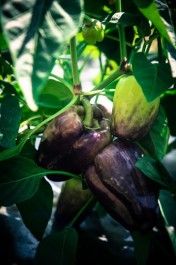With the crazy heat we have been having, there are a few tomatoes starting to blush on the vines, but it will probably be next week before they are in full swing. Green tomatoes can be delicious though, and we will be including some in shares this week. When we have red tomatoes, we are planning to have them available behind the check in tables at your pick up, so that you can direct us as to what kind of sizes and ripeness you prefer; kind of like “deli-style.” Like many things for all of us in 2020, this is "uncharted territory," and we will greatly appreciate your patience as we figure out how this will work!

Did you realize that broccoli is one of the most 'heavily traveled' produce items on grocery store shelves today? While some of the seasonal produce you see in stores may come from area farms (corn, beans, tomatoes, squashes, etc.,) the large majority (90+%) of broccoli that is purchased and consumed in the Eastern United States has been produced in the perpetually drought-stricken state of California.
Even in warm months, the store-bought broccoli on supermarket shelves has usually traveled more than 3,000 miles to reach your plate. Why the distance? Well, much of it is related to climate. The most common varieties of broccoli LOVE the cool weather of the spring and fall. Broccoli can continue growing (although much much slower) even in the winter. At Oxen Hill Farm, we have harvested broccoli in December, as most broccoli can take temperatures as low as 20 degrees for short periods of time. Traditional varieties, however, do not like the hot humid temperatures of summer, so California’s cooler coastal climates allow for essentially year-round production.

Here in the East, though…the times they are a changing…as there is a strong emphasis on producing large quantities of broccoli for the fresh market. Cornell University is leading an effort called The Eastern Broccoli Project, to evaluate growing methods and varieties that do especially well throughout the summer heat. Beginning in 2015, we have been using several varieties that could be long-term foundations for a solid summer broccoli crop for CSA customers and our wholesale accounts; varieties such as: Emerald Pride, Burney, Imperial, Diplomat, and Arcadia.
Broccoli is a challenging crop though, due to its extreme sensitivity to both heat and ethylene gas. Ethylene is a natural compound that is produced as most fruits and vegetables ripen (melons, squash, tomatoes, etc.) However, just the presence of ethylene around harvested broccoli, cauliflower or other sensitive crops will cause yellowing and decay. Therefore it is critical that we harvest broccoli quickly at the coolest times of the day (often 5 am!) and then cool it down as soon as possible, and keep it ventilated and separated from ethylene-producing crops. All of this helps us to ensure that the product you get in your share is the freshest quality and best tasting!
Another challenge for broccoli is that in times of drought, as we have seen for much of this season so far, it has a hard time extracting the chemical element of Boron from the soil. When this happens, some of the heads develop small patches of decay within the heads that are difficult to see from the outside, but quickly decompose and create an unsavory patch within the otherwise lovely and perfectly usable broccoli crown. Our harvest this year has been a bit patchy due to weather conditions, but we hope to have (had) broccoli available for folks who want it within the past few and coming few weeks.
Some of the produce you receive has been rinsed from the field, but like all fresh produce, most of it should be thoroughly washed and refrigerated by you at home.
Peppers will likely be available in your share this week or next. All peppers (and tomatoes) start out green, and some will ripen on the plants (hopefully in another six weeks or so) into vivid colors. We have planted some purple "Islander" peppers as well as those that will ripen to orange, red and yellow.

When stored in the vegetable compartment of the refrigerator, they will keep for 1-2 weeks. If they begin to wrinkle or soften, they are likely just dehydrating, so you don't have to throw them out, just use them right away in a cooked dish. Before coring and/or cutting the pepper, wash it under running water. They are delightful sliced and eaten raw or as a crudite, they make a great pizza topping, and are yummy along with pasta and eggs.
Peppers are one of the few veggies that can be frozen without first being blanched. If you have the freezer space, it is better to freeze them whole since there will be less exposure to air which can degrade both their nutrient content and flavor. Use a paring knife to cut around the stem and then gently remove it. Peppers can be cut into various shapes and sizes. To easily chop, dice or cut the peppers into strips, first cut the pepper in half lengthwise, clean out the core and seeds, and then, after placing the skin side down on the cutting surface, cut into the desired size and shape. Peppers can also be cut horizontally into rings or left whole for stuffed peppers after removing the seeds from the inner cavity.
Here is the week 6 Pinterest board: https://pin.it/brmlpucnpptbmo




